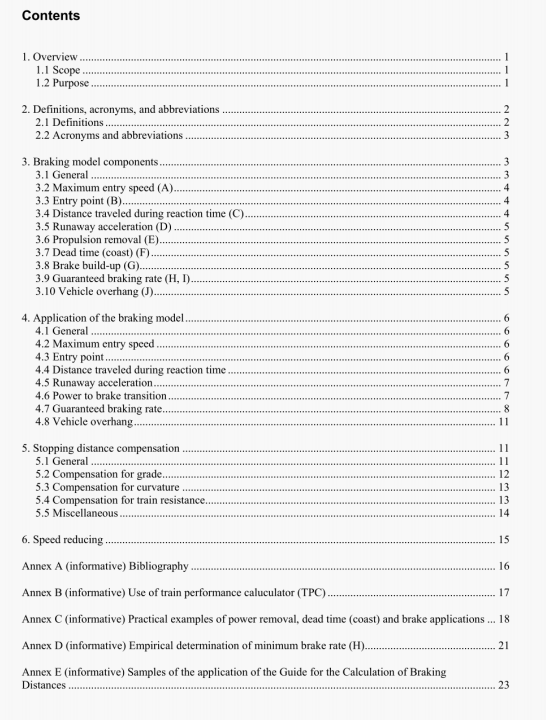IEEE 1698:2009 pdf free download.IEEE Guide for the Calculation of Braking Distances for Rail Transit Vehicles.
Depending on the design and application of the signal system. this component may consist of two parts that are either independent and concurrent or consecutive events.
4.4.1 Equipment reaction time
The distance traveled in this reaction time includes worst-case time fur the wayside andor carbome ATCIATP equipment to detect, process, and indicate a need for braking. This can also include the time for the carbome ATC/ATP equipment to annunciate the more restrictive speed aspect to the train operator.
4.4.2 Operator reaction time
The lime provided for the operator to recognize the need for braking (i.e., based upon visual andor audible annunciation). Operator reaction time should also include any additional time for the operator to suppress the overspeed condition, either by acknowledgement of the overspeed condition andor through a manual application of the brakes.
4.5 Runaway acceleration
The runaway acceleration component D begins at the end of the reaction-lime distance and continues until removal of positive tractive efThrt has been initiated via the action of a high-integrity backup control path, such as a penalty brake application.
This component of the model assumes the maximum acceleration rate for the speed at the end of reaction time, based upon the vehicle performance characteristics. This may include the assumption of a load weigh system failure in conjunction with the weight of an empty vehicle such that the traclive eflort available for a fully loaded vehicle is used.
If the train accelerates at any time during component C the ATP system will deteel an overspeed condition and initiate the start of component D (See NOTE). This will always result in a shorter stopping distance than assuming the overspeed condition (from acceleration or the recognition of a lower speed requirement) occurs precisely at the end of component C. The component D should include the time for the ATP to detect and indicate the overspeed condition to other carbome equipment. This time is typically the time required to recognize overspeed and dc-energize the overspeed brake relay or other output, which initiates the high integrity backup control path.
NOTE For systems without overspeed enforcement, operators are prohibited from exceeding the commanded speed limit by rule.
Random failures of individual pieces of propulsion apparatus are, in general, less severe in their consequences than arc train-wide or systemic luiilures. and arc therefore not separately considered.
Runaway acceleration is typically included in braking models that feature automatic train operation (ATO) andor microprocessor based propulsion control logic. The presence of propulsion controls utilizing non- vital microprocessor technology does not in itself require that a runaway acceleration component of greater than zero time duration be included in a braking model. However, where such a component is not to be included, the development of a comprehensive failure analysis supporting this decision is strongly recommended.
IEEE 1698:2009 pdf free download
